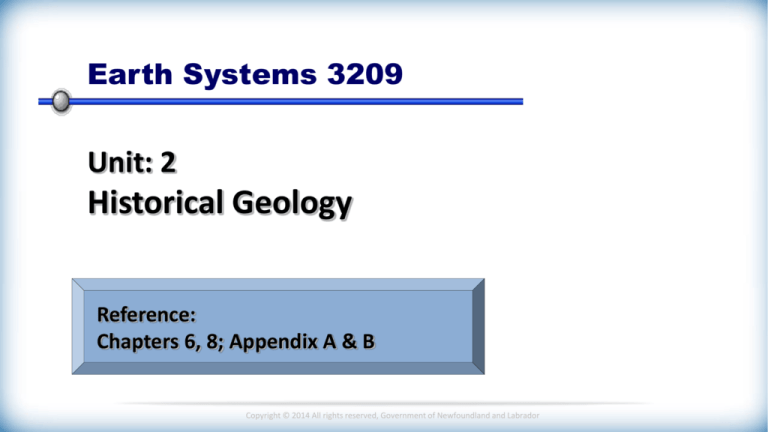
Earth Systems 3209
Unit: 2
Historical Geology
Reference:
Chapters 6, 8; Appendix A & B
Copyright © 2014 All rights reserved, Government of Newfoundland and Labrador
Unit 2:
Topic 3.1
Fossils and Geologic Time
Focus on . . .
define fossil and explain how fossils are used to
subdivide geologic time.
Copyright © 2014 All rights reserved, Government of Newfoundland and Labrador
Fossils and Geologic Time
Fossils:
- are the remains or traces of organisms
found in sedimentary rocks.
When plants and animals die they get buried
in sediment and the soft parts usually decay
with the hard parts being fossilized when the
sediment turns to solid rock.
Fossils provide the basis by which the
subdivisions of the Geologic Timescale are
divided.
Copyright © 2014 All rights reserved, Government of Newfoundland and Labrador
Text Reference:
Pages 183 - 186
Fossils and Geologic Time
The record of life in the geologic past may be biased:
the fossil record shows an abundance of organisms that contained
hard parts and lived in environments of high sedimentation.
However, only a glimpse of the numerous other life forms exist in
the fossil record.
In the early 1800’s an English scientist named William Smith noticed
that the same fossils were identified in the same rock types. This
evidence was the background work for one of the fundamental principles
of historical geology known as the principle of fossil succession.
This principle states, “fossil organisms succeed one another in a
definite and determinable order, and therefore any time period can
be recognized by its fossil content.”
Copyright © 2014 All rights reserved, Government of Newfoundland and Labrador
Fossils and Their Importance in Geology
What is the importance of fossils to geologist? And ….
What does a fossil indicate?
1. Fossils indicate the age of sedimentary rocks.
Within each division of time there are many subdivisions
based on certain species of fossils. For example, the
divisions of the geologic time scale is subdivided
according to the presence and absence of fossils.
This same succession of fossils within sedimentary
rock layers is seen on every major landmass.
Copyright © 2014 All rights reserved, Government of Newfoundland and Labrador
Fossils and Their Importance in Geology
What is the importance of fossils to geologist? And ….
What does a fossil indicate?
2.
Fossils indicate the environments in which rocks formed.
Knowing the nature of life-forms that existed at a particular time may
indicate the environment in which the sedimentary rock formed.
Past environments can be indicated by studying the nature and
characteristics of sedimentary rocks and the fossils they contain.
For example, if clam shells are found in limestone, a geologist could
assume that the region was covered by a shallow sea, because that
is where clams are found today. This assumption coincides with the
idea of uniformitarianism.
Fossil characteristics reveal what type of environment the organism
lived in the past.
Copyright © 2014 All rights reserved, Government of Newfoundland and Labrador
Fossils and Their Importance in Geology
What is the importance of fossils to geologist? And ….
What does a fossil indicate?
3. Fossils are used to correlate (match up) rocks.
Once fossils were recognized as time indicators, they became a useful
means of correlating rocks of similar age in different regions.
Scientist use fossils called index fossils which are widespread
geographically and limited to a short span of geologic time. The presence
of these fossils are important when matching rocks of the same age.
If index fossils are not present, then groups of fossils in the same rocks
are used to correlate rocks of the same age.
Copyright © 2014 All rights reserved, Government of Newfoundland and Labrador
Fossils and Their Importance in Geology
What is the importance of fossils to geologist? And ….
What does a fossil indicate?
4. Fossils provide the basis to subdivide the Geologic Timescale.
By studying characteristics of certain fossils and the type of fossils
present in sedimentary rocks, different aspects of the geologic past
can be interpreted by geologist. Things such as, temperatures,
climate, type of environment, etc….
Copyright © 2014 All rights reserved, Government of Newfoundland and Labrador
Fossils and Their Importance in Geology
What is the importance of fossils to geologist? And ….
What does a fossil indicate?
5. Fossils can also indicate evolutionary pathways.
With an understanding of the principle of fossil succession, when
fossils are arranged according to their age by applying the law of
superposition, fossils in the rocks show a progressive change
demonstrating the evolution of life through time.
For example, an Age of Invertebrates, such as the trilobites,
are recognized early in the fossil record. Then, in succession,
paleontologist recognize an Age of Fishes, an Age of
Amphibians, an Age of Reptiles, and an Age of Mammals.
Thus, it is thought that Invertebrates evolved to form Fish, which
evolved into Amphibians, which evolved into Reptiles, and finally
Mammals.
Copyright © 2014 All rights reserved, Government of Newfoundland and Labrador
Example 1:
Which is used to conclude that Layer B is the
same age as layer D?
(A) fossil correlation
(B) plate tectonics
(C) superposition
(D) uniformitarianism
Copyright © 2014 All rights reserved, Government of Newfoundland and Labrador
Example 2:
Which best describes the progression of life forms
from Precambrian to Cenozoic?
(A) bacteria – dinosaurs – trilobites – mammoths
(B) bacteria – trilobites – dinosaurs – mammoths
(C) dinosaurs – bacteria – mammoths – trilobites
(D) dinosaurs – mammoths – bacteria – trilobites
Copyright © 2014 All rights reserved, Government of Newfoundland and Labrador
Your Turn . . .
Take the time and complete the following questions . . .
(Solutions to follow)
Question:
Which is characteristic of an index fossil?
(A)
(B)
(C)
(D)
limited to a short span of geologic time
only found on continental landmasses
represent the only species of its kind
restricted to a small geographic area
Copyright © 2014 All rights reserved, Government of Newfoundland and Labrador
Solutions . . .
Questions:
Which is characteristic of an index fossil?
(A)
(B)
(C)
(D)
limited to a short span of geologic time
only found on continental landmasses
represent the only species of its kind
restricted to a small geographic area
Copyright © 2014 All rights reserved, Government of Newfoundland and Labrador
Summary . . .
Overview of Points covered:
Fossils - are the remains or traces of organisms found in sedimentary rocks
Importance of Fossils in Geology:
1. Fossils indicate the age of sedimentary rocks.
2. Fossils indicate the environments in which rocks formed.
3. Fossils are used to correlate (match up) rocks.
4. Fossils provide the basis to subdivide the Geologic Timescale.
5. Fossils can also indicate evolutionary pathways..
Copyright © 2014 All rights reserved, Government of Newfoundland and Labrador








